
The German Shepherd, also known in Britain as an Alsatian, is a German breed of working dog of medium to large size. The breed was developed by Max von Stephanitz using various traditional German herding dogs from 1899.

Schutzhund, currently known competitively as IGP and previously as IPO, is a dog sport that tests a dog's tracking, obedience, and protection skills, and evaluates if a dog has the appropriate traits and characteristics of a good working dog. It was developed in Germany in the early 1900s as a suitability test for German Shepherds, but soon became the model for training and evaluating all five of the German protection breeds, which included Boxer, Dobermann, Giant Schnauzer, and Rottweiler. Though any breed of dog can participate, today the sport is dominated by German Shepherds and the Belgian Shepherd breed. Dog owners and handlers participate in Schutzhund clubs as a group activity for training the dogs, and clubs sponsor trials to test the dogs and award titles. The best dogs can qualify to participate in national and international level championships.
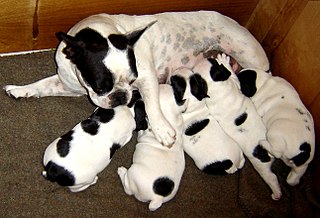
Dog breeding is the practice of mating selected dogs with the intention of maintaining or producing specific qualities and characteristics. When dogs reproduce without such human intervention, their offspring's characteristics are determined by natural selection, while "dog breeding" refers specifically to the artificial selection of dogs, in which dogs are intentionally bred by their owners. Breeding relies on the science of genetics, hence a breeder who is knowledgeable on canine genetics, health, and the intended purpose of the dogs attempts to breed suitable dogs.

A wolfdog is a canine produced by the mating of a domestic dog with a gray wolf, eastern wolf, red wolf, or Ethiopian wolf to produce a hybrid.

A herding dog, also known as a stock dog or working dog, is a type of dog that either has been trained in herding or belongs to breeds that are developed for herding. A dog specifically trained to herd sheep is known as a sheep dog or shepherd dog.
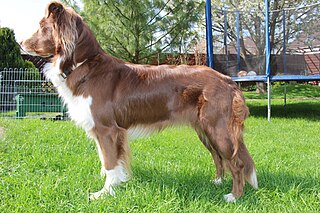
The Australian Shepherd is a breed of herding dog from the United States. The name of the breed is technically a misnomer, as it was developed in California in the 19th century. It is believe to have its origins in sheepdog breeds from northwest Spain, as well as collies imported, alongside sheep, from Australia and New Zealand; the breed reportedly took its name from this trade. Originally used solely as a herding dog, the Australian Shepherd has become one of the most popular companion dog breeds in North America.

A kennel club is an organization for canine affairs that concerns itself with the breeding, showing and promotion of more than one breed of dog. Kennel clubs became popular in the mid 19th century. All-encompassing kennel clubs are also referred to as 'all-breed clubs', although "all" means only those breeds that they have decided to recognize, and "breed" means purebred dogs, not including dog hybrids and crossbreeds or mixed-breed dogs. A club that handles only one breed is known as a breed club.
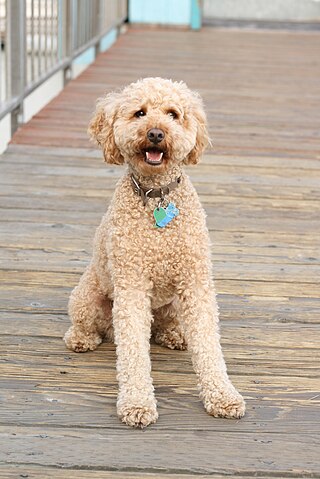
Dog crossbreeds, sometimes called designer dogs, are dogs which have been intentionally bred from two or more recognized dog breeds. They are not dogs with no purebred ancestors, but are not otherwise recognised as breeds in their own right, and do not necessarily breed true.

The Black Russian Terrier, also known as the Chornyi Terrier, is a breed of dog created in USSR in Red Star Kennel during the late 1940s and the early 1950s for use as military/working dogs. At the present time, the Black Russian Terrier is a breed recognized by the FCI, AKC, CKC, KC, ANKC, NZKC and other cynological organizations. The contemporary Black Russian Terrier is a working dog, guarding dog, sporting and companion dog.
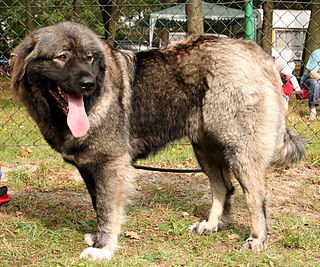
The Caucasian Shepherd Dog or Caucasian Ovcharka is a large livestock guardian dog native to the Caucasus region, notably Georgia, Armenia, Azerbaijan, and Dagestan. It was developed in the Soviet Union from about 1920 from dogs of the Caucasus Mountains and the steppe regions of Southern Russia. The Caucasus Mountains in Georgia has historically been the principal region of distribution of Caucasian Shepherd dogs, both in terms of numbers and the quality of the dogs present in the area.

The Central Asian Shepherd Dog, also known as the Alabay, Alabai and Turkmen Wolf-Hound, is a livestock guardian dog breed. Traditionally, the breed was used for guarding sheep and goat herds, as well as to protect and for guard duty. In 1990, the State Agroindustrial Committee of Turkmenistan approved the standard of the Turkmen Wolf-Hound dog breed.
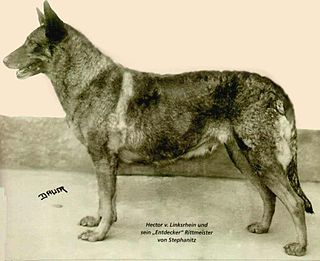
Horand von Grafrath was the first German Shepherd Dog and the genetic basis for modern German Shepherds.

Max Emil Friedrich von Stephanitz was a German cavalry officer and dog breeder. He is credited with having developed the German Shepherd Dog breed as it is currently known, set guidelines for the breed standard, and was the first president of the Verein für Deutsche Schäferhunde (S.V.).

The Taiwan Dog is a breed of small or medium dog indigenous to Taiwan. These dogs are also known as the Formosan Mountain Dog. They are well-adapted to the uneven and thickly forested terrain of Taiwan, having become a semi-wild breed prior to the arrival of several colonial reigns and foreign powers. Notwithstanding these adaptations, Formosans retained the potential to be trained and are now used as hunting dogs, guard dogs, stunt dogs, rescue dogs, or simply as companions. Formosans are classified into one medium type and two small types.
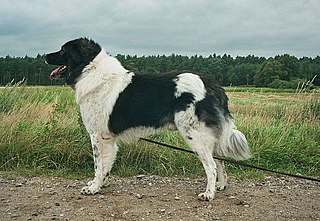
The Karakachan dog is a breed that originated from Bulgaria. It is related to the livestock guardian dogs of the surrounding countries: Romania to the north, North Macedonia and Serbia to the west, and Greece, and Turkey to the south. The dog is named after the Karakachans, Greek nomadic shepherds. Due to their conservative stock-breeding traditions, they have preserved some of the oldest breeds of domestic animals in Europe: the Karakachan sheep, Karakachan horse and the Karakachan dog.

The Verein für deutsche Schäferhunde (SV), in English, German Shepherd Association, is a breed club founded in Germany in 1899 by Max von Stephanitz and his colleague, Arthur Meyer, which set forward the standards of the German Shepherd dog breed.

The Miniature American Shepherd, frequently abbreviated MAS, is a small herding dog breed. The MAS is highly intelligent and biddable. The breed is often trained for dog sports such as herding, agility, obedience, canine freestyle, flyball, and others. The Miniature American Shepherd was recognised by the American Kennel Club (AKC) in 2015 and is the club's 186th breed. In September 2019, the Fédération Cynologique Internationale (FCI) officially accepted the breed.
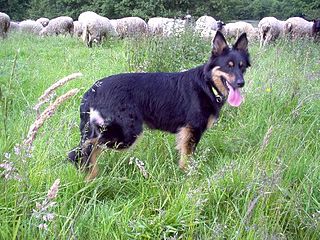
Old German herding dogs, including old German sheep dogs or old German shepherd dogs are a group of traditional types of working, herding dogs from Germany. They are landraces consisting of working strains of dog, and some of them are the types from which the modern German Shepherd Dog was developed as a standardised breed. The landraces are not recognised by the Fédération Cynologique Internationale, but some have their own standards which are for working ability, not appearance traits.

The Alopekis is a small, ancient, primitive landrace of dog from Greece and adjacent regions of the Balkan peninsula. Alopekis have prick ears, a curved tail, and a double coat. Alopekis were bred as a multipurpose farm dog, functioning as a hunting dog, watchdog and shepherd. The dog is found throughout Greece but is most commonly seen in northern Greek regions with a lot of farmland and villages, such as Serres, Drama, Xanthi, etc. Critically endangered, the exact number of specimens that remain today is uunknown.

The Alaskan husky is a breed of medium-sized working sled dog, developed specifically for its performance as such.



















